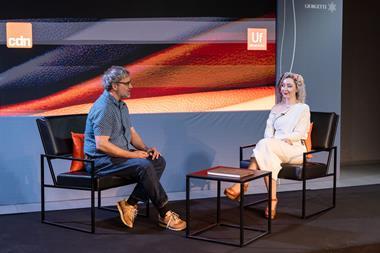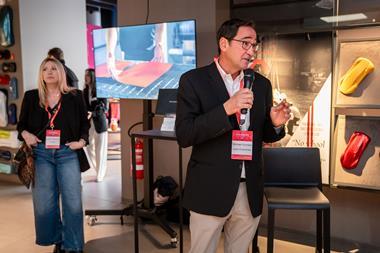IN THIS ISSUE
Interior Motives Design Awards
 Vehicle type: concept/four-door coupe
Vehicle type: concept/four-door coupeDesign Director: Gilles Vidal
Interior Design Director: Amko Leenarts
Chief Designer, Concept Cars: Per Selvaag
Lead Interior Designer: Adam Bazydlo
Interior Designer: Julien Cueff
Colour & trim design: Sophie Gazeau
Design Integration: Samuel Guinefoleau
Project started: November 2010
Project completed: July 2011
Launch: Frankfurt/September 2011
The HX1 features a further evolution of the horizontal, layered 3 interior architecture and very sculptured, 3D surface language previously explored on the company’s SR1 and HX1 concepts. On the transmission tunnel, just above the driver’s armrest, is a discreet touchpad trimmed in matching grey leather milled down to a thickness of just 0.1mm. “There’s no reason why a touchpad today has to be a matte black piece of plastic – you can cover it with anything you want,” says Leenarts. “Instead of having lots of bits and pieces that we have to put into one big bezel, we were able to integrate these elements directly into the leather.” The touchpad operates the foldout screen in the centre console, which is closed in this photo, denoting (along with the rounder steering wheel) that the car is in ‘city’ mode. The matte-silver buttons on the side of the armrest are used to navigate in and out of the infotainment menu.
 Vehicle type: concept/four-door coupe
Vehicle type: concept/four-door coupeTeam leaders: J Mays & Martin Smith
Interior team leader: Ernst Reim
Interior designers: Murat Seven & Dennis Sartorello
Colour & trim team leader: Ruth Pauli
Colour and trim designers: Serife Celebi & Lotte Kanthers
Project manager: Patrick Verhee
Project started: April ‘10 (interior Spring ‘11)
Project completed: August 2011
Launch: Frankfurt/September 2011
The way that the concept’s primary functions wrap around the driver will be a key theme inside future Fords. The touchscreens on the Evos feature three-dimensional OLED displays already in use in Samsung mobile phones.
The front seats (shown here in sketch form) were inspired by classic chair designs by Eames and Jacobsen, but still feature modern safety and comfort functions such as the motorcyclist jacket back protection shield-infl uenced ribbed shell, and air- or liquid-fi lled horizontal fi llets inside that can be adjusted according to user preference.
Vercarmodel’s engineers insert the dashboard assembly through the show car’s beetlecarapace-
style, roof-hinged doors during assembly at its facility in Italy. The build process was overseen by Ford’s supervisor for concept design engineering, Patrick Verhee.
 Vehicle type: production/5-door hatchback
Vehicle type: production/5-door hatchbackDesign Director: Jean-Pierre Ploue &
Thierry Metroz
Interior Design Director: Alexandre Malval &
Andrew Cowell
Interior designers: Christophe Cayrol,
Christophe Pialat & Céline Manetta
Colour & trim designer: Fabien Darche
Project started: spring 2007
Project completed: winter 2010
Launch: Frankfurt/September 2011
The second interior theme was milled in polystyrene in September 2007. This model convinced Citroën management to approve a new direction for the interior and develop a more refi ned hard model in record time for a test clinic in June 2008. “The interior is characterized by the powerful volume of the dashboard, with its asymmetrical instrument façade and high centre console. The façade and the controls have a strong technological character,” points out Malval, before adding, “The dominant central console combining luxury and technology is complemented by the roof console, which appears to be its ‘refl ection’ in the middle of the twin panorama sunroofs.” Both elements contain toggle switches that project the aeronautical theme of the original concept.
FRANKFURT, 14 September 2011: As the doors closed on the final press day of the Frankfurt Motor Show, design students, media and top professionals from around the globe gathered at the renowned Cocoon Club to watch sponsors Peugeot and Volkswagen announce that the 2011 Interior Motives Student Designer of the Year is Felix Godard, from France’s Strate Collège.
“True genius” was the description of his work by Peugeot Interior Design Director Amko Leenarts. In fact Godard’s futuristic Metis Age concept scored a unanimous victory in the Best Artistic Visualisation category. It then went on to earn its French creator the accolade of overall Student Designer of the Year along with prize money of $5,500.
“It's been a long time since I've seen something so beautiful,” added Ford's Global Director for Interiors, Scott Strong, one of the other judges. “It challenges you to rethink the way we explore design.”
A strong contender for the overall title was Neuron, by Ian Kettle from the UK’s Royal College of Art. His innovative exploration of brain-machine interface technology – winner of the coveted Best Conceptual Interior award – was called “just irresistible” by Citröen’s Head of Advanced Interior Design, Andreas Stump.
Another major hit with the judging panel was Liviu Tudoran’s wildly inventive Fractal concept, whose interior changes shape and colour according to need. It was called “a new interior concept – one that realises maximum complexity in a simple way” by Wolfgang Müller-Pietralla of Volkswagen’s Future Research department.
Other winning entries include RCA student Adam Phillips with his superbly executed Group Dynamics design study, which took a fresh new look at interior ergonomics, and Diet Mini by last year’s Student Designer of the Year Kosin Voravattayagon, which netted its creator the Best Production Interior Award for the second year in a row. Also carrying off individual awards were Julliana Cho’s striking electric commuter car Memory Piece, X-AVR by Michael Canty of the USA’s Academy of Art, and Da Vinci by Marcello Basilio of the Istituto Europeo di Design (IED) in Italy.
This year is the 9th annual Interior Motives Student Design Awards. For full details of the winners, finalists and shortlisted entries – including images of all the finalists’ work – click here. A full report of the 2011 awards ceremony is available on Car Design News here.
ABOUT THE AWARDS: Hundreds of entries from dozens of schools
Prizes will be awarded in the following categories:
-
Best eco interior
-
Best use of technology
-
Best innovative interior
-
Best ergonomics
-
Best conceptual interior
-
Best production interior
-
Best conceptual exterior
-
Best artistic visualisation
Magazine






























































